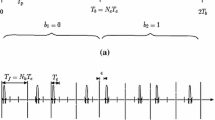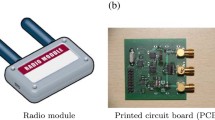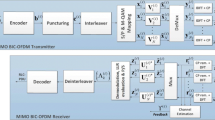Abstract
UWB (Ultra Wideband) systems tend to suffer strong interference from signals that occupy a significant part of the transmission band. This is an important constraint, especially when the channel remains fixed for a long period of time. In order to overcome this limitation, this paper considers UWB systems employing Single-Carrier with Frequency-Domain Equalization techniques. We propose the corresponding receiver, which also allows the soft packet combining associated to different Automatic Repeat ReQuest transmission attempts, as a measure to improve the performance through the exploitation of diversity. Our techniques are able to cope with strong interference levels as well as deep fading, even for fixed channels.
Similar content being viewed by others
References
Shen, X., Guizani, M, Qiu, R. C., & Le-Ngoc, T. (2006). Ultra-wideband - wireless communications and networks. N.J., USA: Wiley.
Win M., Scholtz R. (1998) On the robustness of ultra-wide bandwidth signals in dense multipath environments. IEEE Communications Letters. 2(2): 10–12
Ramrez-Mireles F., Scholtz R. (2001) On the performance of ultra- wide-band signals in Gaussian noise and dense multipath. IEEE Transactions on Vehicular Technology. 50(1): 244–249
Siwiak K. (2001) Impact of ultra wide band transmissions on a generic receiver. IEEE VTC’ 01(Spring) 2: 1181–1183
Luediger H., Zeisberg S. (2000) User and business perspectives on an open mobile access standard. IEEE Commmunications Magazine 38(9): 160–163
Win M., Scholtz R. (1998) Impulse radio: How it works. IEEE Communications Letters, 2(2): 36–38
Win M., Scholtz R. (2000) Ultra-wide bandwidth time-hopping spread-spectrum impulse radio for wireless multiple-access communications. IEEE Transactions on Communications 48(4): 679–689
Ishiyama, Y., & Ohtsuki, T. (2004). Performance evaluation of UWBIR and DS-UWB with MMSE-frequency domain equalization (FDE). IEEE GLOBECOM’04.
Popescu, D., Yaddanapudi, P., & Kondadasu, R. (2005). OFDM versus time-hopping in multiuser ultra wideband communication systems. IEEE VTC’05 (Spring).
Gusmão, A., Dinis, R., Conceição, J., & Esteves, N. (2000). Comparison of two modulation choices for broadband wireless communications. IEEE VTC’00 (Spring), Tokyo, Japan.
Falconer D., Ariyavisitakul S., Benyamin-Seeyar A., Eidson B. (2002) Frequency domain equalization for single-carrier broadband wireless systems. IEEE Communications Magazine 4(4): 58–66
Dinis, R., Gusmão, A., & Esteves, N. (2003). On broadband block transmission over strongly frequency-selective fading channels. In Proceedings of Wireless 2003, Calgary, Canada.
Montezuma, P., & Gusmão, A. (2001). A pragmatic coded modulation choice for future broadband wireless communications. IEEE VTC’2001(Spring), Rhodes, Greece.
Benvenuto N., Dinis R., Falconer D., Tomasin S. (2010) Single carrier modulation with non linear frequency domain equalization: An idea whose time has come—again. IEEE Proceedings 98(1): 69–96
Benvenuto N., Tomasin S. (2002) Block iterative DFE for single carrier modulation. IEE Electronics Letters 39(19): 1144–1145
Gusmão A., Dinis R., Esteves N. (2003) On frequency-domain equalization and diversity combining for broadband wireless communications. IEEE Transactions on Communications 51(7): 1029–1033
Vucetic B., Yuan J. (2002) Turbo codes: Principles and applications. Kluwer, Dordrecht
Dinis R., Kalbasi R., Falconer D., Banihashemi A. (2004) Iterative layered space–time receivers for single-carrier transmission over severe time-dispersive channels. IEEE Communications Letters 8(9): 579–581
Marques da Silva, M., Correia, A., Dinis, R., Souto, N., & Silva, J. (2010). Transmission techniques for emergent multicast and broadcast systems (1st ed.). New York, USA: CRC Press Auerbach Publications. ISBN:9781439815939.
Gusmão, A., Torres, P., Dinis, R., & Esteves, N. (2006). A class of iterative FDE techniques for reduced-CP SC-based block transmission. In International symposium on turbo codes.
Hagenauer J. et al (1988) Rate-compatible punctured convolutional codes (RCPC Codes) and their application. IEEE Transactions on Communications 36(4): 389–400
Gusmão, A., Dinis, R., & Esteves, N. (1999). Adaptive HARQ schemes using punctured RR codes for ATM-compatible broadband wireless communications. IEEE VTC’99 (Fall), Amsterdam, The Netherlands.
Dinis, R., & Gusmão, A. (1998). Transmission techniques for increased power efficiency in OFDM-based wireless communication systems. IEEE RAWCON’98, Colorado Springs, USA.
Author information
Authors and Affiliations
Corresponding author
Rights and permissions
About this article
Cite this article
Marques da Silva, M., Dinis, R. & Montezuma, P. Iterative Frequency-Domain Packet Combining Techniques for UWB Systems with Strong Interference Levels. Wireless Pers Commun 70, 501–517 (2013). https://doi.org/10.1007/s11277-012-0704-5
Published:
Issue Date:
DOI: https://doi.org/10.1007/s11277-012-0704-5




